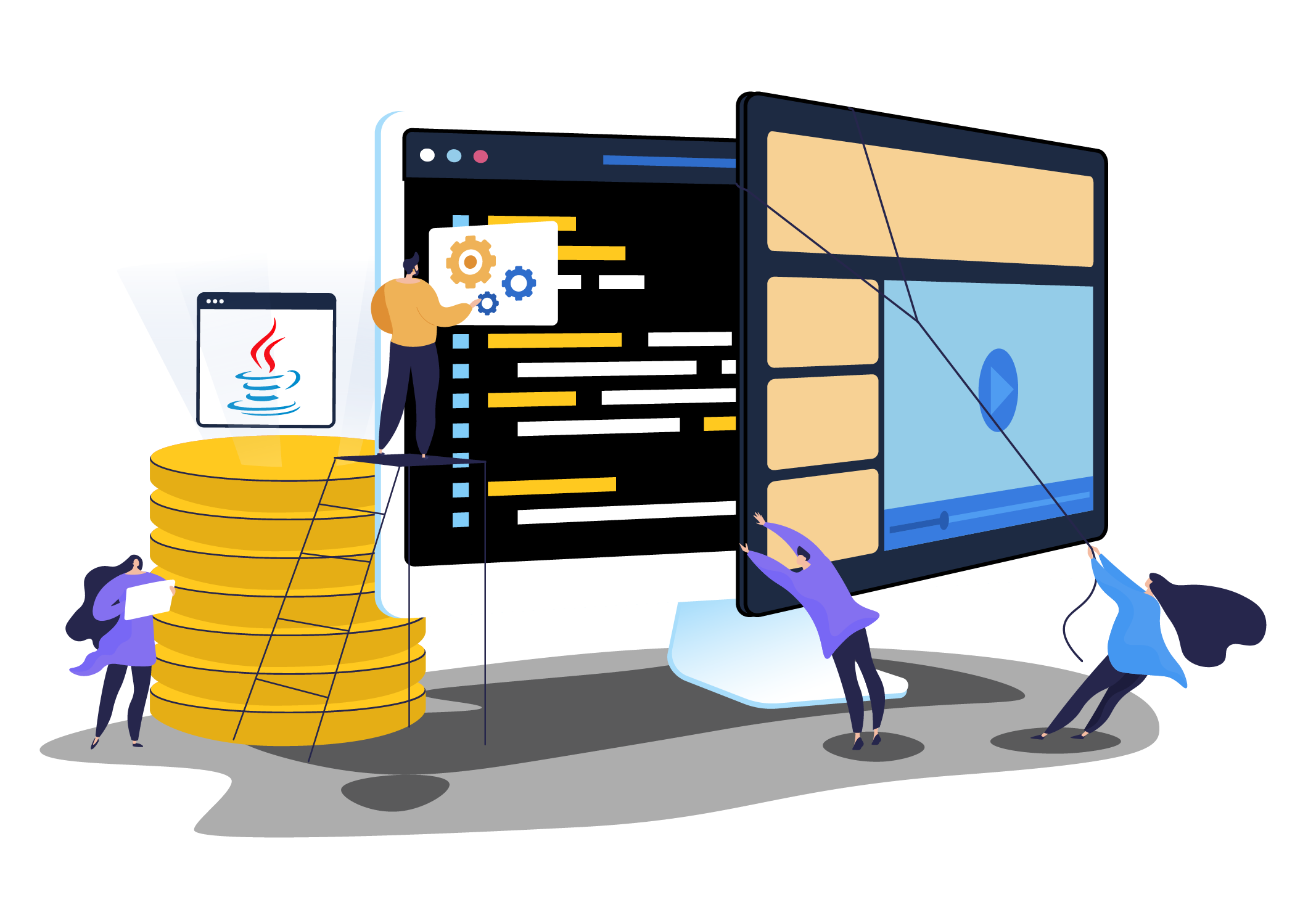Introducing Trendsetting Innovation in Java Backend Development
It’s vital to acknowledge Java’s critical role in fostering innovation in the backend development space as we set out on this trip. Web apps are built on the backend, which includes database interactions and server-side logic that drive the user-facing frontend. The technology that jumps out in this context is Java, which is known for its adaptability, stability, and scalability.
When it comes to Java for backend development, it has a significant influence that cannot be ignored. This section provides an overview of Java’s expertise in backend development, including its benefits, evolution, and comparison to other industrial technologies.
Java backend development serves as essential for backend development because of its versatility and stability. It enables programmers to create high-performance, scalable backend systems that effectively manage intricate business logic and data processing. Also, programmers may expedite time-to-market and simplify development workflows with the help of Java’s vast ecosystem of libraries, frameworks, and tools.
It enables programmers to create high-performance, scalable backend systems that effectively manage intricate business logic and data processing. Also, programmers may expedite time-to-market and simplify development workflows with the help of Java’s vast ecosystem of libraries, frameworks, and tools.
Within the Java backend framework, the topic statement, “Java’s Role in Driving Backend Development Innovation,” emphasizes how Java has revolutionized backend development methodologies. Java keeps pushing the envelope in backend development, underpinning anything from enterprise-grade apps to innovative solutions in fields like cloud computing and microservices architecture.
Our discussion’s goals and parameters include analyzing Java’s contributions to the field of backend development, highlighting its salient characteristics, and going over practical instances of how it has been used to create dependable and scalable backend systems. By dissecting Java’s foundation for backend development, we hope to shed light on how this technology promotes growth, innovation, and corporate advancement in the always changing digital environment.
Tracing Evolution, Unveiling Advantages, and Industry Comparison of Java’s Backend Brilliance
Java backend development serves as essential for backend development because of its versatility and stability. It enables programmers to create high-performance, scalable backend systems that effectively manage intricate business logic and data processing. Also, programmers may expedite time-to-market and simplify development workflows with the help of Java’s vast ecosystem of libraries, frameworks, and tools.
The story of Java’s journey in backend programming is one of creativity and flexibility. When Java was first developed in the middle of the 1990s, it was meant to be a language for consumer electronics. But its object-oriented design, portability, and strength soon made it a popular option for backend development. Java has developed steadily over time, with updates and improvements guaranteeing its continued applicability in contemporary backend development settings.
Java has a wealth of features and benefits, which contribute to its appeal in backend development. Java provides developers with a comprehensive toolkit for creating reliable, scalable backend systems, thanks to its huge standard library, scalability, and independence from other platforms. Its community support is also noteworthy. Furthermore, Java is the best option for mission-critical applications due to its integrated security measures, support for enterprise-level frameworks like Spring, and multithreading capabilities.
Java provides developers with a comprehensive toolkit for creating reliable, scalable backend systems, thanks to its huge standard library, scalability, and independence from other platforms. Its community support is also noteworthy. Furthermore, Java is the best option for mission-critical applications due to its integrated security measures, support for enterprise-level frameworks like Spring, and multithreading capabilities.
Java holds its own against other backend technologies in the competitive marketplace. Although Node.js and Python have their own merits, Java stands out due to its maturity, performance, and rich ecosystem. Dynamically typed languages cannot match the stability and predictability offered by Java’s statically typed structure. Java’s reputation as a leading player in the backend development space is further cemented by its extensive history in enterprise settings and its interoperability with contemporary technologies like cloud computing and microservices architecture.
Environment Setup, System Mastery, and Expert Practices; Java’s Backend Expedition
Setting up an environment, creating a system, and using professional methods are all part of the painstaking process of integrating backend technologies in Java. This section explores the nuances of this journey, offering details on every aspect.
Getting the Java environment set up is the first step towards developing backend applications. Installing the Java Development Kit (JDK), setting up development environments like Eclipse or IntelliJ IDEA, and integrating necessary tools like Maven or Gradle for project build automation and dependency management are all part of this process. Additionally, in order to create scalable and portable development environments, developers might investigate containerization technologies such as Docker.
Building reliable, scalable systems that can meet the needs of contemporary applications is at the core of backend development.  Because of its performance and adaptability, Java is the best option for this purpose. To create modular and extensible backend systems, developers use Java’s object-oriented programming paradigm. To speed up development and provide scalable microservices or monolithic apps, they make use of frameworks like Jakarta EE or Spring Boot. On top of that, developers may create systems that effectively manage multiple user requests and data processing activities thanks to Java’s support for multithreading and concurrency control.
Because of its performance and adaptability, Java is the best option for this purpose. To create modular and extensible backend systems, developers use Java’s object-oriented programming paradigm. To speed up development and provide scalable microservices or monolithic apps, they make use of frameworks like Jakarta EE or Spring Boot. On top of that, developers may create systems that effectively manage multiple user requests and data processing activities thanks to Java’s support for multithreading and concurrency control.
When it comes to backend development, following best practices and using professional advice is crucial. This entails developing error-handling and logging systems that are reliable, adhering to architectural principles like MVC or RESTful APIs, and producing clear and maintainable code. In addition, developers need to put security first by using safe coding techniques, putting authorization and authentication systems in place, and updating dependencies frequently to fix security flaws.
Performance, Security, and Concurrency Mastery; Backend Elevation of Java
Java is a shining example of backend development, providing methods to improve speed, strengthen security, and address concurrency issues. The importance of Java in advancing backend systems is discussed in this section.
A strong foundation for backend speed optimization is offered by Java. It’s multithreading features, effective memory management, and sophisticated optimization methods are used by developers to make backend apps run faster and more responsive. To optimize resource usage and fine-tune performance, strategies like caching systems, database query optimization, and code optimization are used. Additionally, Java’s non-blocking I/O and asynchronous processing capabilities let programmers create scalable, high-performance backend systems that can easily handle demanding workloads.
Backend development with Java places a high priority on security, and it provides reliable ways to secure data and fend off attacks. Building safe backend applications is made easier by Java’s built-in security capabilities, which include cryptography libraries, access control methods, and bytecode verification. Developers employ optimal methodologies, like input validation, encryption, and secure authentication systems, to guarantee data integrity and forestall illegal access or manipulation of confidential data. Furthermore, Java’s adherence to security guidelines and frequent upgrades guarantee that backend applications continue to be secure against constantly changing security risks.
Java gives developers the necessary tools to handle the inherent complexity of load management and concurrency, which are challenges in backend programming. The Executor framework and other concurrency tools, along with Java’s support for multithreading and thread synchronization, allow programmers to create highly concurrent backend systems that can effectively handle numerous concurrent requests. Java also provides cluster management, distributed computing, and load balancing technologies, enabling developers to efficiently handle different traffic volumes and scale backend programs horizontally.
Casting Light on Futuristic Insights, Synergistic Technologies, and Success Stories of Java’s Backend
Java’s expertise continues to be one of the most innovative and dependable languages used in the ever-changing backend development industry. The upcoming developments and trends that will shape Java’s place in backend development are examined in this part, along with actual success stories that demonstrate the platform’s long-lasting influence.
Due to its resilience, scalability, and flexibility, experts predict that Java will have a bright future in the backend development space. With the industry’s acceptance of cloud-native apps, microservices architecture, and containerization, Java is the go-to option for developing robust backend systems because to its portability and interoperability with contemporary technology. Development workflows are also anticipated to be further streamlined and developer productivity increased by Java framework innovations like Jakarta EE and Spring Boot.
The future of Java in backend development is entwined with new trends and technologies that enhance its capabilities. Java offers a flexible framework for developing cutting-edge solutions, from the emergence of serverless computing and event-driven architectures to the incorporation of AI and ML. Additionally, new possibilities for developing scalable, responsive, and robust backend systems are made possible by the convergence of Java with technologies like GraphQL, Kubernetes, and reactive programming paradigms.
Success examples from the real world show how Java is still useful and successful for backend development. Businesses from a range of sectors have used Java to develop vital backend systems that drive their online products. For instance, millions of customers worldwide receive flawless streaming experiences from Netflix thanks to its microservices design, which is built on Java. Similar to this, LinkedIn uses Java to manage large-scale data processing jobs and keep its professional networking platform connected in real-time. Furthermore, Java is used by banks such as Goldman Sachs to create safe, efficient trading systems that process millions of transactions every day.
Visionary Innovation with Pattem Digital; Key Takeaways, and Future Outlook of Java
It’s clear from our exploration of Java’s significance in backend development that the language continues to be a major innovator in the digital space. Java continues to improve the backend development environment with its strong speed improvements and unwavering security safeguards. To open up new possibilities in their projects, backend developers are urged to embrace Java’s adaptability and keep up with developing trends.
Being a Java development company, Pattem Digital is a reliable partner for people looking for professional advice and help implementing Java-based backend solutions. With a track record of producing creative, dependable, and scalable software solutions, Pattem Digital provides full Java programming services that are customized to fit the particular requirements of companies in a range of industries. Put your trust in Pattem Digital to successfully navigate your backend development projects by utilizing Java’s full potential.





